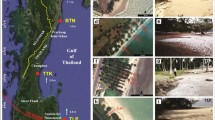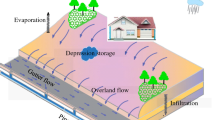Abstract
Identifying coastal stretches that are likely to erode under high wave conditions is essential to the coastal management community in addressing beach erosion-related issues. The manuscript presents a case study to predict erosion of a selected beach located on the eastern Indian coast during the 2018 southwest (SW) monsoon season. The pre-monsoon beach topography surveyed using DGPS is used as the initial topographic condition in the morphological model. The model simulates subsequent beach erosion during the SW monsoon season, which is forced by forecast waves. Beach erosion advisories that classify the beach as eroding, accreting and no change are disseminated with a lead period of 10 days. During the SW monsoon period, we have monitored the beach using the dumpy level, and the beach topography during the post-monsoon is generated using DGPS surveyed profiles and are used for model validation. The beach area under erosion observed from the model result is homologous with the in-situ observations. The model shows cross-shore sediment transport to dominate during the SW monsoon, particularly in the central and northern sectors of RK beach. The model estimated shoreline position agrees with the DGPS observations, where the central sector has undergone maximum erosion. The comparison shows the model’s ability to simulate beach morphodynamics like landward shifting of the berm crest under a high wave setup and oscillating water levels due to tides. The study highlights the importance of numerical modelling systems that decipher the beach response to the high monsoon waves.
Research highlights
-
Beach erosion forecast system for RK Beach, India.
-
Forecast system is developed using a combination of WAVEWATCHIII and Xbeach.
-
Beach erosion advisories during monsoon period.










Similar content being viewed by others
References
Adamo F, Capua C D, Filianoti P, Lanzolla A M L and Morello R 2014 A coastal erosion model to predict shoreline changes; Measurements 47 734–740, https://doi.org/10.1016/j.measurement.2013.09.048.
Ahammed K K B and Pandey A C 2019 Shoreline morphology changes along the eastern coast of India, Andhra Pradesh by using geospatial technology; J. Coast. Conserv. 23 331–351, https://doi.org/10.1007/s11852-018-0662-5.
Alexandrakis G, Manasakis C and Kampanis N A 2015 Valuating the effects of beach erosion to tourism revenue. A management perspective; Ocean. Coast. Manag. 111 1–11.
APCZMA 2018 Minutes of the meeting of Andhra Pradesh Coastal Zone Management Authority, A.P. Secretariat, Velagapudi, Amaravati on 10-01-2018.
Ardhuin F, Erick R, Alexander B V, Jean-Francois F, Rudy M, Aaron R, Van Der Westhuysen A, Pierre Q, Jean-Michel L, Lotfi A and Fabrice C 2010 Semi empirical Dissipation Source Functions for Ocean Waves. Part I: Definition, calibration, and validation; J. Phys. Oceangr. 40(9) 1917–1941.
Baart F and vander Kaaiji T, van Ormondt A, van Koningsveld M and Roelvink J A 2009 Real-time forecasting of morphological storm impacts: A case study in the Netherlands; J. Coast. Res. 56 1617–1621.
Baart F, van Ormondt M, de Vries J S M and van Koningsveld M 2016 Morphological impact of a storm can be predicted three days ahead; Comput. Geosci. 90 17–23.
Ballesteros C, Jimenez J A, Valdemoro H I and Bosom E 2018 Erosion consequences on beach functions along the Maresme coast (NW Mediterranean, Spain); Nat. Hazards 90 173–195.
Bergillos R J, Ortega-Sanchez M, Masselink G and Losada M A 2016 Morpho-sedimentary dynamics of a micro-tidal mixed sand and gravel beach, Playa Granada, southern Spain; Mar. Geol. 379(1) 28–38, https://doi.org/10.1016/j.margeo.2016.05.003.
Davidson M A, Turner I L, Splinter K D and Harley M D 2017 Annual prediction of shoreline erosion and subsequent recovery; Coast. Eng. 130 14–25, https://doi.org/10.1016/j.coastaleng.2017.09.008.
Herring T A, King R W and McClusky S C 2010 Introduction to GAMIT/GLOBK, Release 10.4; MIT, Cambridge, MA, 48p.
Jaménez J A, Gracia V, Valdemoro H I, Mendoza E T and Sanchez-Arcilla A 2011 Managing erosion-induced problems in NW Mediterranean urban beaches; Ocean Coast. Manag. 54 907–918.
Kankara R S, Selvan S C, Markose V J, Rajan B and Arockiaraj S 2015 Estimation of long and short term shoreline changes along Andhra Pradesh coast using Remote Sensing and GIS techniques; In: Procedia Engineering, 8th International Conference on Asia and Pacific Coasts (APAC 2015) 116 855–862.
Mandal A K, Ratheesh R, Pandey S, Rao A D and Kumar P 2020 An early warning system for inundation forecast due to a tropical cyclone along the east coast of India; Nat. Hazards 103 2277–2293, https://doi.org/10.1007/s11069-020-04082-w.
Mentaschi L, Vousdoukas M I, Pekel J F, Voukouvalas E and Feyen L 2018 Global long-term observations of erosion and accretion; Sci. Rep. 8 12876, https://doi.org/10.1038/s41598-018-30904-w.
Noujas V and Thomas K V 2015 Erosion hotspots along southwest coast of India; Aquatic Procedia 4 548–555.
Pacheco A, Williams J J, Ferreira O, Garel E and Reynolds S 2011 Applicability of sediment transport models to evaluate medium term evolution of tidal inlet systems; Estuar. Coast. Shelf Sci. 95 119–134.
Panigrahi J K, Kumar V S and Tripathy J K 2010 Littoral drift by alongshore flow at Visakhapatnam – East coast of India; J. Hydro-Environ. Res. 4 317–327.
Plant N G and Stockdon H F 2012 Probabilistic prediction of barrier-island response to hurricanes; J. Geophys. Res. 117 F03015.
Prasad K V S R, Arun S V V K, Ramu V and Sreenivas P 2009 Significance of nearshore wave parameters in identifying vulnerable zones during storm and normal conditions along Visakhapatnam coast, India; Nat. Hazards 49 347–360.
Price T D, Castelle B, Ranasinghe R and Ruessink B G 2013 Coupled sandbar patterns and obliquely incident waves; J. Geophys. Res. 118 1677–1692.
Rajawat A S, Chauhan H B, Ratheesh R, Rode S, Bhanderi R J, Mahapatra M, Kumar Mohit, Yadav R, Abraham S P, Singh S S, Keshri K N and Ajai 2015 Assessment of coastal erosion along the Indian coast on 1:25,000 scale using satellite data of 1989–1991 and 2004–2006 time frames; Curr. Sci. 109 347–354.
Rao K N, Subraelu P, Rajawat A S and Ajay 2008 Beach erosion in Visakhapatnam: Causes and Remedies; East. Geographer. XIV 1–6.
Ratheesh R, Agrawal R, Remya P G, Naga Kumar KCh V, Demudu G, Rajawat A S, Nair B and Rao K N 2018 Modelling coastal erosion: A case study of Yarada beach near Visakhapatnam, east coast of India; Ocean Coast. Manag. 156 239–248.
Razak Ab M S, Dastgheib A and Roelvink D 2013 Sand bypassing and shoreline evolution near coastal structure comparing analytical solution and XBeach numerical modelling, Proceedings 12th International Coastal Symposium (Plymouth, England); J. Coast. Res. 65 2083–2088.
Remya P G, Ranjan T R, Sirisha P, Harikumar R and Nair B 2020 Indian Ocean wave forecasting system for wind waves: Development and its validation; J. Oper. Oceanogr. 15(1) 1–16, https://doi.org/10.1080/1755876X.2020.1771811.
Reniers A J H M, Gallagher E L, MacMahan J H, Brown J A, van Rooijen A A, van Thiel de Vries J S M and van Prooijen B C 2013 Observations and modeling of steep-beach grain-size variability; J. Geophys. Res. 118 577–591.
Roelvink J A, Reniers A, van Dongeren A, van Thiel De Vries J, Lescinski J and McCall R 2010 XBeach Model Description and Manual; Delft, The Netherlands.
Roelvink J A, Reniers A, van Dongeren A and van Thiel De Vries J, McCall R and Lescinski J, 2009 Modelling storm impacts on beaches, dunes and barrier islands; Coast. Eng. 56 1133–1152.
Sarma K G S 2015 Siltation and coastal erosion at shoreline harbours; Procedia Eng. 116 12–19.
Semeoshenkova V and Newton A 2017 Overview of erosion and beach quality issues in three Southern European countries: Portugal, Spain and Italy; Ocean Coast. Manag. 118 12–27, https://doi.org/10.1016/j.ocecoaman.2015.08.013.
Suvarna B, Mohan C H P and Sunitha V 2017 Textural analysis of coastal sands from Ramakrishna Beach-Bhumunipatnam tract (Visakhapatnam) East Coast of India; J. Indian Geophys. Union. 21(3) 207–213.
Thinh A A, Thanh N N, Tuyen L T and Hens L 2019 Tourism and beach erosion: Valuing the damage of beach erosion for tourism in the Hoi An World Heritage site, Vietnam; Environ. Dev. Sustain. 21 2113–2124, https://doi.org/10.1007/s10668-018-0126-y.
Tolman H L 1991 A third-generation model for wind waves on slowly varying, unsteady and inhomogeneous depths and currents; J. Phys. Oceanogr. 21 782–797.
van Rooijen A A 2011 Modelling sediment transport in the Swash Zone; Thesis, Delft University of Technology, 142p.
Vousdoukas M, Ferreira O, Almeida L P and Pacheco A 2012 Towards reliable storm-hazard forecasts: XBeach calibration and its potential application in an operational early-warning system; Ocean Dyn. 62 1001–1015.
Acknowledgements
We thank Shri Nilesh Desai, Director, SAC-ISRO, Ahmedabad, for his support. We express our gratitude to Dr I M Bahuguna, Deputy Director, EPSA and Dr R P Singh, Group Director, GHCAG/EPSA SAC-ISRO, for their support and encouragement. We also thank Director, ESSO-INCOIS, Hyderabad and Ministry of Earth Science (MoES) for the support. This work is carried out in collaboration between Space Applications Centre (SAC, ISRO), Ahmedabad and INCOIS, Hyderabad (INCOIS Contribution No. 466).
Author information
Authors and Affiliations
Contributions
All authors contributed to the preparation of final manuscript. Material preparation, data collection and analysis were performed by Ratheesh, Remya, Ritesh, Gireesh and Amarendra.
Corresponding author
Additional information
Communicated by Maripi Dileep
Rights and permissions
About this article
Cite this article
Ratheesh, R., Remya, P.G., Agrawal, R. et al. A numerical modelling approach for beach erosion forecast during the southwest monsoon season. J Earth Syst Sci 131, 220 (2022). https://doi.org/10.1007/s12040-022-01968-0
Received:
Revised:
Accepted:
Published:
DOI: https://doi.org/10.1007/s12040-022-01968-0




